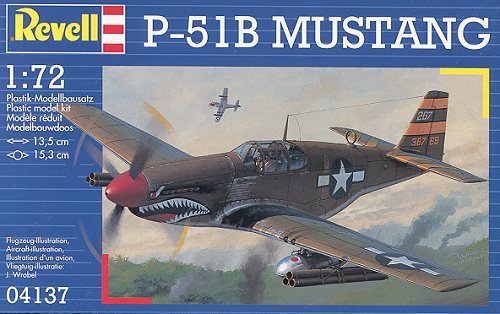
Revell AG 1/72 P-51B Mustang
|
KIT # |
4317 |
|
PRICE: |
$5.95 MSRP |
|
DECALS: |
See review |
|
REVIEWER: |
Rick Crabill |
|
NOTES: |

|
HISTORY |

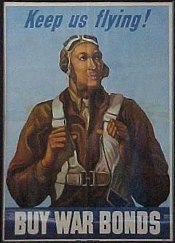 In the 1930’s and early 1940’s, the US military was as strictly
segregated and racist as civilian society. Black soldiers and sailors
were relegated to menial labor or service jobs, being little more than
cooks, ditchdiggers, or servants to White officers. Nowhere was this
harsh policy more evident than in the US Army Air Corps. Although Blacks
were as aviation-minded as any Americans, and Black aviators had flown
many record breaking flights, the White military establishment held
to the mistaken notion that Negroes were intellectually and physically
inferior, and incapable of anything as difficult as learning to
fly. It was claimed “ The jump from the plow to the airplane is too much
for the colored man”. The Commander of the Air Corps, General Hap Arnold,
went so far as to state “Negro pilots cannot be used in our units since
this would result in Negro officers serving over white enlisted men
(which is) an impossible social situation”. However, in one of the many
ironies of the saga of the Tuskegee Airmen, Nazi Germany forced the hands
of the White American military establishment. The need for America to
build up its air power to fight Adolph Hitler, an avowed racist and
virulent white supremacist, was the catalyst for a call to arms for all
US fighting men, regardless of color.
In the 1930’s and early 1940’s, the US military was as strictly
segregated and racist as civilian society. Black soldiers and sailors
were relegated to menial labor or service jobs, being little more than
cooks, ditchdiggers, or servants to White officers. Nowhere was this
harsh policy more evident than in the US Army Air Corps. Although Blacks
were as aviation-minded as any Americans, and Black aviators had flown
many record breaking flights, the White military establishment held
to the mistaken notion that Negroes were intellectually and physically
inferior, and incapable of anything as difficult as learning to
fly. It was claimed “ The jump from the plow to the airplane is too much
for the colored man”. The Commander of the Air Corps, General Hap Arnold,
went so far as to state “Negro pilots cannot be used in our units since
this would result in Negro officers serving over white enlisted men
(which is) an impossible social situation”. However, in one of the many
ironies of the saga of the Tuskegee Airmen, Nazi Germany forced the hands
of the White American military establishment. The need for America to
build up its air power to fight Adolph Hitler, an avowed racist and
virulent white supremacist, was the catalyst for a call to arms for all
US fighting men, regardless of color.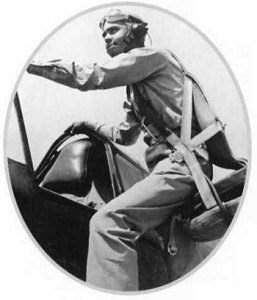
In spite of the urgent need for massive numbers of pilots for the Allied war effort, segregationist Air Corps officers were determined to keep African-Americans from military flight school, so they tried to set up the program to fail. They chose to make the first Black squadron a fighter squadron, since this was the most difficult type of military flying. It was also felt that, by training pilots to fly single-seat fighters instead of a bomber with an eight or ten man crew, they could limit the number of black pilots trained. The site chosen for training was Tuskegee, Alabama – the heart of the Jim Crow South. Tuskegee Army Airfield opened on July 23, 1941.
Overcoming racism and outright hostility, the first pilots (including Lt. Col. Benjamin Davis, Jr., who would lead them into combat) graduated on March 7, 1942. On August 24th of that same year, the 99th Fighter Squadron, the first African-American combat squadron in US history was formed. The Tuskegee Airmen were now prepared to go to war.
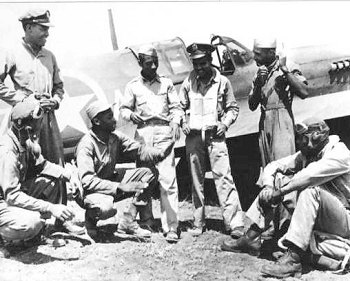 Flying in North Africa, and later Sicily and Italy, the 99th was
given the unglamorous but essential task of close air support. Their
expertise in dive-bombing and strafing enemy troops were a key element of
victory in the battle of Anzio in Italy. Using worn out aircraft
discarded by other squadrons, the Black Birdmen were highly praised by
Allied ground commanders for their bravery and determination. Throughout the latter half of 1943 the 99th Squadron
proved that Black Americans could fly, and fight, for their country. But
an even more glorious chapter in the history of the Tuskegee Airmen
was about to be written.
Flying in North Africa, and later Sicily and Italy, the 99th was
given the unglamorous but essential task of close air support. Their
expertise in dive-bombing and strafing enemy troops were a key element of
victory in the battle of Anzio in Italy. Using worn out aircraft
discarded by other squadrons, the Black Birdmen were highly praised by
Allied ground commanders for their bravery and determination. Throughout the latter half of 1943 the 99th Squadron
proved that Black Americans could fly, and fight, for their country. But
an even more glorious chapter in the history of the Tuskegee Airmen
was about to be written.
In 1944, the 100th, 301st, and 302nd Fighter Squadrons joined the 99th
to form the 332nd Fighter Group, which chose as its’ emblem a
winged Black Panther. All the planes in the Group had their tails painted
a bright red for easy identification. Still an all-Black organization,
the 332nd’s new mission with its P-51 Mustangs was escorting Allied
bombers on their missions deep within enemy territory. Col. Davis, now
Group commander, instructed his pilots to protect the bombers at all
costs, since he knew that Air Corps bigwigs were looking for any excuse
to deactivate the unit. Denied the opportunity to run up high scores in
air-to air combat like other pilots, the men of the 332nd were so
effective in their role of escorts that not a single Allied bomber under
their care was lost to enemy fighters. This record was never equaled by
any other Fighter Group in the Army Air Corps! Commanders of bomber
squadrons specifically requested the “Red-Tails” for their escort on many
occasions. Indeed, so great was the reputation of the 332nd Fighter Group
that German fighters often refused to fight against them, choosing
instead to attack other formations once they recognized the crimson
tailed Mustangs of the Tuskegee Airmen.
Air Corps insistence on keeping the African-American Fighter Group segregated meant that all maintenance and ground personnel were also Black. This backfired in the face of the white military brass, since many of these mechanics and support staff went on after the war to distinguished careers in aviation. In spite of working with hand–me-down aircraft and being forced to scrounge vital parts, these hardworking men were able to keep the planes and pilots flying and fighting. So much for the idea that Blacks did not have the mechanical aptitude for such things!
The wartime record of the Tuskegee Airmen was outstanding. Flying over 15,000 sorties, they destroyed or damaged over 500 enemy aircraft, countless locomotives, trucks, and other vehicles, and even sank a destroyer by gunfire. They were awarded 150 Distinguished Flying Crosses, 744 Air Medals and Clusters, 14 Bronze Stars, the Red Star of Yugoslavia, and even a Presidential Distinguished Unit Citation for “outstanding performance of duty in armed conflict with the enemy”. But their greatest accolade came on July 26, 1948, when US President Harry Truman signed Executive Order # 9981, which declared “that there shall be equality of treatment and opportunity for all persons in the armed services without regard to race, color, religion or national origin”. The U.S. military was now officially desegregated. An important victory for Civil Rights, and the rights of all Americans, had been won.
|
THE KIT |
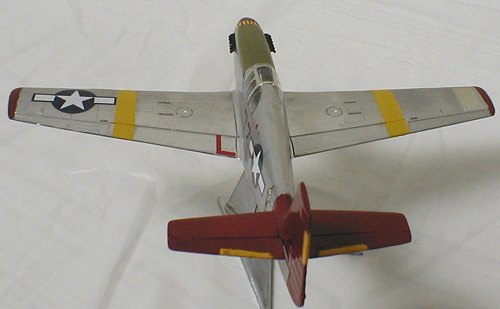 For an idea of what the kit is like in the box, here is a preview of
the very similar
Mustang III
For an idea of what the kit is like in the box, here is a preview of
the very similar
Mustang III
|
CONSTRUCTION |
The kit is the RoG new issue, built OOB very quickly at a local Make n’ Take. It sat unpainted on the shelf for a year before I was inspired to finish it for Black History Month at my church. It went together very well - the make-n-take featured this kit, the RoG Hurricane IIb, and an FW-190A/F. The local IPMS guys were worried that the kits would be too much for the kids, but all three turned out to be easy "slammers". Parts fit was excellent, with a good cockpit interior. No real problems with seams, especially considering that it was built fast, using that cheap orange-smelling glue that is COMPLETELY NON-TOXIC, but has virtually no gripping power.I recall that the canopy fit better than the one on the old Monogram Blue Box P-51. The panel line detail was very restrained.
|
COLORS AND MARKINGS |
 Aero Master decal sheet # 72-125 depicting aircraft flown by five
Tuskegee Airmen was used (kindly donated by Chris Mikesh of Nostalgic
Plastic). This is an excellent sheet with some very colorful schemes.
I chose to model the P-51C Mustang “INA The MACON BELLE” flown by Lt. Lee
“Buddy” Archer, 302nd Fighter Squadron, 332nd Fighter Group. Lt. Archer
had four confirmed victories as well as one unconfirmed. Three of his
victories were achieved on a single mission on October 13th, 1944.
Lee Archer survived the war and was alive as recently as January 2002. A
P-51C owned by Kermit Weeks in Florida has been fully restored as “Ina”. Overall
color was Testor’s spray Chrome, with some panels covered in BareMetal
foil for contrast. Insignia Red and Yellow were used for the markings.
The yellow wing stripes were masked. Trim tabs were hand painted.
Aero Master decal sheet # 72-125 depicting aircraft flown by five
Tuskegee Airmen was used (kindly donated by Chris Mikesh of Nostalgic
Plastic). This is an excellent sheet with some very colorful schemes.
I chose to model the P-51C Mustang “INA The MACON BELLE” flown by Lt. Lee
“Buddy” Archer, 302nd Fighter Squadron, 332nd Fighter Group. Lt. Archer
had four confirmed victories as well as one unconfirmed. Three of his
victories were achieved on a single mission on October 13th, 1944.
Lee Archer survived the war and was alive as recently as January 2002. A
P-51C owned by Kermit Weeks in Florida has been fully restored as “Ina”. Overall
color was Testor’s spray Chrome, with some panels covered in BareMetal
foil for contrast. Insignia Red and Yellow were used for the markings.
The yellow wing stripes were masked. Trim tabs were hand painted.
All in all, an excellent buy for the money, and a worthy rival to the Hasegawa 1/72nd P-51 kits.
|
REFERENCES |
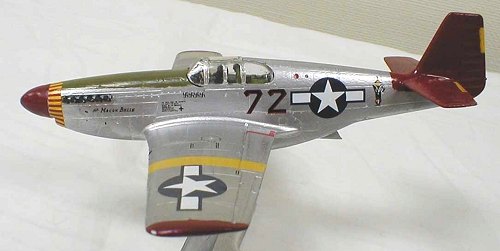 "The Tuskegee Airmen: The Men Who Changed a Nation" by Charles Francis,
c. 1993 by Branden Pub. Co.
"The Tuskegee Airmen: The Men Who Changed a Nation" by Charles Francis,
c. 1993 by Branden Pub. Co.
"Black Knights" by Lynn Homan& Thomas Reilly, c. 2001 by Pelican
Publishing Co.
"Red Tails/Black Wings" by John B. Holway, c. 1997 by Yucca Tree Press
"The Tuskegee Airmen: Black Heroes of World War II" by Jacqueline Harris,
C. 1996 by Dillon Press
"Red-Tail Angels" by Patricia and Frederick McKissack, c. 1995 by Walker
Publishing Co.
Googling can gather further information on “Lee Archer” and “Tuskegee
Airmen”
February 2004
If you would like your product reviewed fairly and quickly , please contact me or see other details in the Note to Contributors.